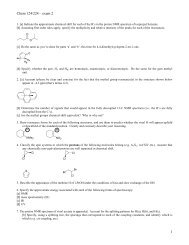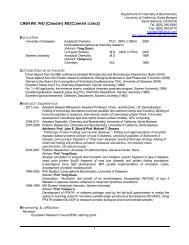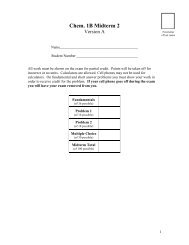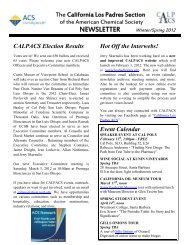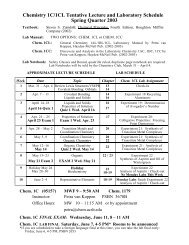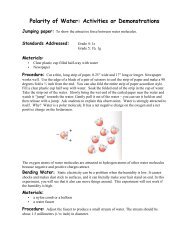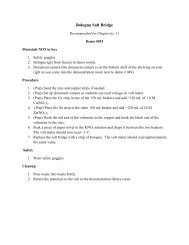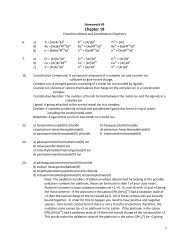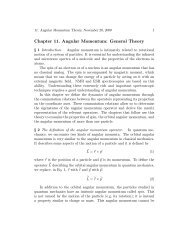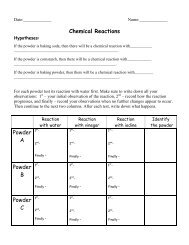29 Si NMR Some Practical Aspects - Pascal-Man
29 Si NMR Some Practical Aspects - Pascal-Man
29 Si NMR Some Practical Aspects - Pascal-Man
Create successful ePaper yourself
Turn your PDF publications into a flip-book with our unique Google optimized e-Paper software.
Gelest, Inc.<br />
1. In the case of narrow signals, the smallest sweep width possible should<br />
be used.<br />
2. Population transfer pulse programs such as DEPT otr INEPT can be used if the silicon atoms are coupling<br />
with protons or fluorine for example.<br />
3. If broad lines are measured, you might be able to subtract it from a blanc spectrum obtained under otherwise<br />
identical conditions.<br />
One other characteristic feature regarding spectra of organosilicon compounds is usually observed under broad<br />
band decoupling of protons. Resonances of silicon atoms containing organic substituents split into many lines<br />
by spin-spin couplings with the protons. This is mostly prevented by decoupling experiments. However, the<br />
Nuclear Overhauser Effect (NOE) can then lead to zero signals, if the ( <strong>29</strong> <strong>Si</strong>, 1 H) dipol-dipol contribution T DD 1<br />
to the other longitudinal relaxation paths of the silicon is close to 1.52. The relaxation times depend on the<br />
correlation times of a molecule, therefore, the signal intensity of a <strong>29</strong> <strong>Si</strong> spectrum with NOE varies with the<br />
temperature. Again there are three ways to turn around the situation:<br />
1. Adding of shiftless relaxation reagents, for example the well-known Cr(acac) 3 in a concentration of<br />
~10 -2 mol/l).<br />
2. Using of inverse gated decoupling. Here proton decoupling is only active during aquisition with long<br />
waiting times (3 to 5 times the relaxation time T 1 ) between scans. The advantage of not polluting the<br />
sample is offset by ineffective use of spectrometer time which can be alleviated somewhat by using<br />
shorter pulses (40°) and shorter recovery times (20s).<br />
3. Use of population transfer pulse programs such as INEPT or DEPT [5].<br />
A third disadvantage in measuring silicon <strong>NMR</strong> spectra is related especially with “pure’’ inorganic compounds<br />
containing only <strong>29</strong> <strong>Si</strong> as an, for <strong>NMR</strong> experiments, useful nucleus. In such cases single pulse experiments are<br />
applicable only. Due to the slow relaxation in such compounds, a 30° pulse is used with repetition rates of<br />
about 20s.<br />
Solid state silicon-<strong>29</strong> <strong>NMR</strong> differs from these solutions inasmuch as the spatial interactions are not averaged<br />
out by particle motion, resulting in broad lines and all the problems are related to that fact. Literature about<br />
<strong>29</strong><strong>Si</strong> solid state <strong>NMR</strong> is given in reference [6].<br />
3. Chemical shifts<br />
The majority of <strong>29</strong> <strong>Si</strong> <strong>NMR</strong> shifts are found in a range between +50 and -200 ppm. However, as far as we know<br />
the current upfield and downfield “world records’’ are formed by divalent silicon compounds. The largest<br />
upfield shift is measured for the decamethylsilicocene (1) with -392 ppm [7]. The highest downfield shift is<br />
given for compound 2 with 567 ppm [8].<br />
AZmax TEL: 035543-1630 • FAX: 03-5543-0312 • www.azmax.co.jp<br />
(215) 547-1015 • FAX: (215) 547-2484 • www.gelest.com<br />
211




